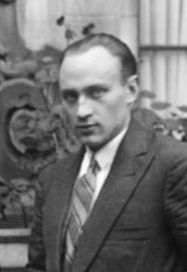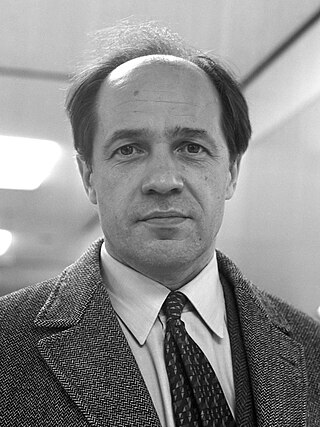Related Research Articles

Paul Sacher was a Swiss conductor, patron and billionaire businessman. At the time of his death Sacher was majority shareholder of pharmaceutical company Hoffmann-La Roche and was considered the third richest person in the world with an estimated net worth of US$13 billion.

Klaus Huber was a Swiss composer and academic based in Basel and Freiburg. Among his students were Brian Ferneyhough, Michael Jarrell, Younghi Pagh-Paan, Toshio Hosokawa, Wolfgang Rihm, and Kaija Saariaho. He received the Ernst von Siemens Music Prize in 2009, among other awards.
Polyphonie X (1950–51) is a three-movement composition by Pierre Boulez for eighteen instruments divided into seven groups, with a duration of roughly fifteen minutes. Following the work's premiere, Boulez withdrew the score, stating that it suffered from "theoretical exaggeration". Despite Boulez's dissatisfaction with the piece, it played a key role in his development: one writer called it "the linchpin connecting Boulez's early mastery of gesture and contour... with his later interest in large ensembles and grand forms", his "brave 'first attempt' to produce a work that exhausted a particular musical technique with large orchestral forces by developing an expansive, additive structure at the earliest stages of composition", and "one of the purest representations of Boulez's first turn toward integral serialism".

Le Marteau sans maître is a chamber cantata by French composer Pierre Boulez. The work, which received its premiere in 1955, sets surrealist poetry by René Char for contralto and six instrumentalists. It is among his most acclaimed compositions.
Pierre Boulez composed three piano sonatas: the First Piano Sonata in 1946, the Second Piano Sonata in 1947–48, and the Third Piano Sonata in 1955–57 with further elaborations up to at least 1963, though only two of its movements have been published.
Structures I (1952) and Structures II (1961) are two related works for two pianos, composed by the French composer Pierre Boulez.

Incises (1994/2001) and Sur Incises (1996/1998) are two related works of the French composer Pierre Boulez. The pitches of the row used in Incises and Sur Incises are based on the Sacher hexachord, the same as those used in the rows for Répons, Messagesquisse, and Dérive 1.

Rituel in memoriam Bruno Maderna (1974–75) is a composition for orchestra in eight groups by Pierre Boulez. Biographer Dominique Jameux wrote that the piece has "obvious audience appeal", and that it represented a desire to establish "immediate, almost physical contact with the public". Jameux also noted that Rituel represents one of the few examples of repetitive music written by Boulez. Author Jonathan Goldman wrote that, of Boulez's works, Rituel is the one that "most evokes... the sound worlds of non-Western musical ensembles, be they Indonesian, African or South American."
York Höller is a German composer and professor of composition at the Hochschule für Musik Köln.
Répons is a composition by French composer Pierre Boulez for a large chamber orchestra with six percussion soloists and live electronics. The six soloists play harp, cimbalom, vibraphone, glockenspiel/xylophone, and two pianos. It was premiered on 18 October 1981 at the Donaueschingen Festival. The composer expanded it until its completion in 1985. The work is dedicated to Alfred Schlee "on his 80th birthday".

The Sacher hexachord is a hexachord notable for its use in a set of twelve compositions created at the invitation of Mstislav Rostropovich for Sacher's seventieth birthday in 1976.
...explosante-fixe... is a piece of music composed by Pierre Boulez. Initially conceived in 1971 as a memorial for Igor Stravinsky, who died in April of that year, several different versions of the work were composed by Boulez between 1972 and 1993, culminating in a piece for solo MIDI-flute and chamber orchestra.

Luciano Berio was an Italian composer noted for his experimental work, and for his pioneering work in electronic music. His early work was influenced by Igor Stravinsky and experiments with serial and electronic techniques, while his later works explore indeterminacy and the use of spoken texts as the basic material for composition.
The Asko Concerto is a concerto for chamber orchestra by the American composer Elliott Carter. The work was commissioned by the Dutch chamber group Asko Ensemble, for which the piece is titled. It was composed in January 2000 and was first performed in Concertgebouw, Amsterdam on April 26, 2000, by the Asko ensemble under the conductor Oliver Knussen. The piece is dedicated to Asko/Schönberg.
The Concerto for six instrumental formations and two solo instruments is a work composed by Jean Barraqué, started in 1962 and finished in 1968.

Le Soleil des eaux is a two-movement cantata for soprano, choir and orchestra by Pierre Boulez, based on two poems by René Char, and having a total duration of about nine minutes.

Dérive 1 is a composition for six-part instrumental ensemble by French composer Pierre Boulez. It was composed in 1984.
Réveil des oiseaux is a work by Olivier Messiaen for piano and orchestra written in 1953. Messiaen invoked birdsong in this composition, as he had in the earlier Quatuor pour la fin du temps (1941). In Réveil des oiseaux he used bird song motifs throughout.
Domaines is a composition by Pierre Boulez. Written during 1961–1968, it exists in two versions, one for clarinet solo, the other for clarinet solo and six instrumental groups. Like a number of other Boulez works of this period, it uses mobile form.
Cummings ist der Dichter is a 1970 composition for mixed choir and instrumental ensemble by Pierre Boulez, based on a poem by E. E. Cummings.
References
- 1 2 Stowell 1999, p. 144.
- 1 2 Stephenson 2002, p. 239.
- 1 2 "eSACHERe World Premiere of unique set of 12 works, solo cello: František Brikcius". MFiles. Retrieved 18 April 2024.
- ↑ Potter 2024, p. 176.
- 1 2 "Boulez - Messagesquisse for violoncello solo and 6 violoncellos". Universal Edition. Retrieved 18 April 2024.
- ↑ Keillor n.d.
- ↑ Bonnet 1987, p. 174.
- ↑ Jameux 1991, p. 197.
- ↑ Bradshaw 1986, p. 222.
- ↑ Campbell 2000, p. 206.
- ↑ Potter 2024, p. 177–181.
- ↑ "Pierre Boulez (1925-2016) / Messagesquisse (1976) for solo cello and six cellos, named after Paul Sacher". IRCAM. Retrieved 18 April 2024.
- ↑ "Pierre Boulez (1925-2016) / Messagesquisse (2000) version for solo viola and six violas". IRCAM. Retrieved 18 April 2024.
- ↑ "Boulez - Messagesquisse for viola solo and 6 violas". Universal Edition. Retrieved 18 April 2024.
- ↑ "Pierre Boulez (1925-2016) / Messagesquisse (2016) version for viola and tape". IRCAM. Retrieved 18 April 2024.
- ↑ "Pierre Boulez / Messagesquisse / 2021 / Premiere". IRCAM. Retrieved 18 April 2024.
- ↑ "Jimi Tenor - Deutsche Grammophon ReComposed". Jazz Music Archives. Retrieved 18 April 2024.
- ↑ Rutherford-Johnson 2017, p. 84.
- ↑ Holland 1999.
- ↑ Tommasini 2016.
- ↑ Whittall 1984.
Sources
- Bonnet, Antoine (1987). "Ecriture and perception: on Messagesquisse by Pierre Boulez". Contemporary Music Review. 2 (1): 173–209.
- Bradshaw, Susan (1986). "The Instrumental and Vocal Music". In Glock, William (ed.). Pierre Boulez: A Symposium. New London: Eulenberg Books.
- Campbell, Edward (2000). Boulez, Music and Philosophy. Cambridge University Press.
- Holland, Bernard (23 November 1999). "Music Review: Savoring the Phases of Boulez's Art". The New York Times. Retrieved 18 April 2024.
- Jameux, Dominique (1991). Pierre Boulez. Harvard University Press.
- Keillor, John (n.d.). "Pierre Boulez: Messagesquisse, for solo cello & 6 cellos". AllMusic. Retrieved 18 April 2024.
- Potter, Caroline (2024). Pierre Boulez: Organised Delirium. The Boydell Press.
- Rutherford-Johnson, Tim (2017). Music After the Fall: Modern Composition and Culture Since 1989. University of California Press.
- Stephenson, Lesley (2002). Symphony of Dreams: The Conductor and Patron Paul Sacher. Scarecrow Press.
- Stowell, Robin (1999). "Other solo repertory". In Stowell, Robin (ed.). The Cambridge Companion to the Cello. Cambridge University Press.
- Tommasini, Anthony (12 June 2016). "Review: NY Phil Biennial's Ambitious Wrap-Up, From Boulez to Bolcom". The New York Times. Retrieved 18 April 2024.
- Whittall, Arnold (January 1984). "Messagesquisse, for Seven Cellos by Pierre Boulez". Music & Letters. 65 (1): 126–127.